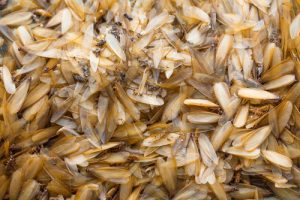Termite Swarming – What to Look For
By Chris Williams on April 26, 2011.
Q. For the last few years we have had what look like flying ants come out in our basement by the furnace. This happens for a day or two in the spring, then they are gone but little wings are all over the place. My neighbor said I should get it checked out as it may be termites, is she correct?
A. Your neighbor is right, it does sound like a termite swarm. Termite swarming takes place on warm, sunny days from January thru June in the Northeastern United States. The swarm is made up of reproductive termites. Future king and queen termites rush out of the ground and pair up. These reproductive forms, or alates, are black in color. Both male and female alates are the same size, roughly 6mm in length, and have two pairs of wings that are about twice as long as their bodies. The four wings are all the same size, and fall off soon after emergence. The presence of wings in a basement or other area if the home is an indication of termite activity. Ants also produce winged reproductive forms at different times during the year. Male and female ants are different sizes, and retain their wings for a longer period of time. Queen ants chew their wings off after mating, and are large in comparison to the smaller wasp like males. Ant swarming may take place at any time from January through late fall, while termite swarming only take place in late winter and spring. Ant bodies have a well defined separation between the thorax (segment where the wings attach, just behind the head) and abdomen, while the all black termites are broadly joined. Ant antennae are visibly bent or elbowed in comparison to the straight, bead-like antennae of the termite alate.
Termite colonies form when two alates, the king and queen, mate and find a suitable location to start a family. Swarming within a structure will not lead to colony formation in most instances. Mated alates need to find shelter from predators within moist soil, preferably under a piece of wood, or near an old log or stump. Bark mulch offers excellent opportunities for newly mated pairs: moisture and food! Termite colonies develop slowly and may not survive the first few years if conditions are unfavorable. Female subterranean termites have a tremendous reproductive capacity and may lay tens of thousands of eggs in their lifetime (14-25 years). The king and queen termite stay together for life.
Over time the colony develops a caste system due to pheromones produced by the queen termite. Several castes form a division of labor within the colony. The colony is made up of primary reproductives(king and queen), workers(maintain the nest, care for eggs and young, forage for food, feed the colony), soldiers(defend against ants and other termite colonies), and secondary reproductives(alates and supplementary queens). Each caste has specific duties depending on the needs of the colony. The relative number of each caste is determined by the queen termite.
 It takes between 3 and 5 years for a termite colony to reach reproductive maturity and produce it’s first swarm. The first swarm may consist of less than 100 alates. Under the right conditions the swarm will increase annually in both number of alates and duration. Successive swarming will leave thousands of wings laying about if not cleaned up. Relatively few termites will survive the swarm, an few of those that mate will go on to form viable colonies. Once established, a colony may persist for more than 20 years.
It takes between 3 and 5 years for a termite colony to reach reproductive maturity and produce it’s first swarm. The first swarm may consist of less than 100 alates. Under the right conditions the swarm will increase annually in both number of alates and duration. Successive swarming will leave thousands of wings laying about if not cleaned up. Relatively few termites will survive the swarm, an few of those that mate will go on to form viable colonies. Once established, a colony may persist for more than 20 years.
Termites live in the soil, and create a nest made of soil, saliva, and fecal material. Mud tunnels are built to move through the soil and into food sources. When swarming occurs, alates gather at the exit point, where workers build an opening in the mud. This may form a swarm castle, and may look like a little tube jutting up from a crack in the foundation, floor, or wall. Swarm castles may also resemble a pile of loose soil, suddenly appearing behind the furnace. The entire colony is a controlled environment with just the right living conditions. Moisture is a constant need, as well as the never ending search for cellulose containing food sources. This search for food may lead termites to wooden structural members. Feeding is accelerated by available moisture and proximity to the soil. As the colony grows it’s demand for food also increases. Over time damage can accumulate and be a major concern for the homeowner. Termite damage is not only costly to repair, but may also lead to unwanted negotiations at the time of sale or re-financing. Home inspections often uncover termite damage and activity that was unknown to the homeowner.
Colonial Pest Control offers the ideal way to protect your most valuable asset from termite damage. The Sentricon®Termite Colony Elimination System featuring Recruit HD is the most environmentally-friendly termite control product available, with over 16-years of proven efficacy and performance in termite colony elimination. This claim is documented by 30 independent University trials and 45 peer-reviewed published research studies. If you think you have termites or are interested in a free estimate and inspection, call us at Colonial Pest Control.